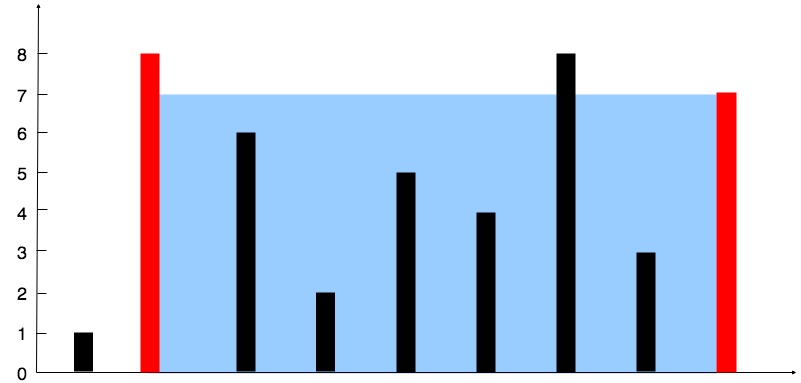题目
Given n non-negative integers a1, a2, …, an , where each represents a point at coordinate (i, ai). n vertical lines are drawn such that the two endpoints of line i is at (i, ai) and (i, 0). Find two lines, which together with x-axis forms a container, such that the container contains the most water.
Note: You may not slant the container and n is at least 2.

The above vertical lines are represented by array [1,8,6,2,5,4,8,3,7]. In this case, the max area of water (blue section) the container can contain is 49.
Example:
Input: [1,8,6,2,5,4,8,3,7]
Output: 49
翻译
给定 n 个非负整数 a1,a2,…,an,每个数代表坐标中的一个点 (i, ai) 。在坐标内画 n 条垂直线,垂直线 i 的两个端点分别为 (i, ai) 和 (i, 0)。找出其中的两条线,使得它们与 x 轴共同构成的容器可以容纳最多的水。
**说明:**你不能倾斜容器,且 n 的值至少为 2。
解法
使用贪心算法
- 首先假设我们找到能取最大容积的纵线为 i, j (假定i < j),那么得到的最大容积
C = min( ai , aj ) * ( j- i); - 下面我们看这么一条性质:
①: 在 j 的右端没有一条线会比它高!假设存在k |( j < k && ak > aj),那么 由ak > aj,所以min(ai, aj, ak) =min(ai, aj),所以由i, k构成的容器的容积C’ = min(ai, aj) * (k - i) > C,与C是最值矛盾,所以得证j的后边不会有比它还高的线;
②:同理,在i的左边也不会有比它高的线;这说明什么呢?如果我们目前得到的候选: 设为 x, y两条线(x< y),那么能够得到比它更大容积的新的两条边必然在[x, y]区间内并且ax’ >= ax , ay’ >= ay; - 所以我们从两头向中间靠拢,同时更新候选值;在收缩区间的时候优先从x, y中较小的边开始收缩;
public int maxArea(int[] height) {
// 参数校验
if (height == null || height.length < 2) {
return 0;
}
// 记录最大的结果
int result = 0;
// 左边的竖线
int left = 0;
// 右边的竖线
int right = height.length - 1;
while (left < right) {
// 设算当前的最大值
result = Math.max(result, Math.min(height[left], height[right]) * (right - left));
// 如果右边线高
if (height[left] < height[right]) {
int k = left;
// 从[left, right - 1]中,从左向右找,找第一个高度比height[left]高的位置
while (k < right && height[k] <= height[left]) {
k++;
}
// 从[left, right - 1]中,记录第一个比原来height[left]高的位置
left = k;
}
// 左边的线高
else {
int k = right;
// 从[left + 1, right]中,从右向左找,找第一个高度比height[right]高的位置
while (k > left && height[k] <= height[right]) {
k--;
}
// 从[left, right - 1]中,记录第一个比原来height[right]高的位置 right = k;
}
}
return result;
}
以上解法耗时5ms左右,算是相当快的一种方式了,但是代码较为复杂,下边提供一种代码较为简单,也比较暴力的一种解法,耗时会在10ms左右
public int maxArea(int[] height) {
int res = 0, i = 0, j = height.length - 1;
while (i < j) {
res = Math.max(res, Math.min(height[i], height[j]) * (j - i));
if (height[i] < height[j]) ++i;
else --j;
}
return res;
}
总结
刚才经历了正则表达水匹配的难关,所以来一道稍微简单点的题,有种拨开云雾见天晴的感觉。这道题其实直接暴力解决也未尝不可,就是暴力吧,先选左边再选右边。但在此基础上加了一些优化,取左边时,若是height[i] < height[i - 1]时,就直接跳过此条左边的余下操作,因为此时无论怎么选右边,矩形面积都不会比max大。取右边时,若是右边大于等于当前左边,即height[j] >= height[i],则在比较完max后,跳过此条左边操作,因为在此条左边的情况下,之后的面积都不会比当前大了。
Github地址:https://github.com/Bylant/LeetCode
优快云地址:https://blog.youkuaiyun.com/ZBylant
微信公众号

























 164
164

 被折叠的 条评论
为什么被折叠?
被折叠的 条评论
为什么被折叠?








